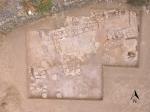Summary (English)
In 2016, the Brock University Archaeological Project at Pantelleria (BUAPP) returned to the Lago di Venere to expand the excavation area based on the test trenches examined in the previous season with the aims of questioning the interpretation of the site as a sanctuary and beginning to define the relationship between the Punic and Roman phases. The importance of the landscape to the development of the site is also a central concern. The construction and maintenance of this site near the shore of a brackish, thermal volcanic crater-lake, and at a considerable distance from the Acropolis must be for significant reasons. One point of conjecture for the project is that the special quality of the crystal blue thermal, yet non-potable, water drew people to this location because of a potential chthonic connection.
The main area of investigation consisted of extending the main test trench from the previous season that contained numerous wall and floor features. This area revealed that the architectural feature is a multi-room structure. The construction techniques of dry-stone masonry with wide wall bases and no terracotta roof tiles suggest Punic work. The absence of a clear ancient destruction layer and the presence of a substantial amount of Roman period materials suggests the possibility that this structure was constructed in the Punic period and continued to exist through the Roman period, or at least that Punic construction techniques were maintained into the Roman period. In parallel, the diagnostic pottery continued to point to the Punic and Roman periods, dating primarily from the third to century BC to the first century AD. A considerable amount of fragmented, plaster architectural decorations were found through the site; these types are also found on the Pantelleria Acropolis (Müller 2015: 465-481). Also of note is a fragment of a terracotta female votive, a marble toe, and plaster corner volute possibly from an altar. These finds in association with the architecture cautiously add to the interpretation of this area as a sanctuary.
BUAPP continues to question the impetus behind the construction of the site and the potential multiple functions of the area, perhaps a combination of sacred and secular activities. The significance of the Lago di Venere site must be examined in connection with other projects on the island and its broader significance for the central Mediterranean. The location of the former edge of the lake in antiquity is still unclear. The spatial relationship between the lake and the architectural features of the site continue to be investigated. A closer dialogue is now underway to compare architectural techniques found at the Lago di Venere with the Pantelleria Acropolis and other Punic sites in Sicily and North Africa. The Lago di Venere site is also being considered as a possible context of worship at a volcanic landscape feature, which forms part of a significant field throughout Sicily and Italy.
- Carrie Ann Murray - Department of Classics - Brock University
Director
Team
- Eoin O’Donoghue -University of Galway
- Maxine Anastasi - University of Malta
- Brian Abfal — Michael Anderson — Kait Hall — Cameron Komdeur — Brittanee Mason — Alex Moore — Sarah Murray — Jennae Rhines —Heather Roy — Raquel Smith — Matt Snider (Brock University)
- Kate Kreindler - Stanford University
Research Body
Funding Body
- Humanities Research Institute, Brock University






![Download [PDF]](/excavation/skins/fasti/images/results/download_sml.png)